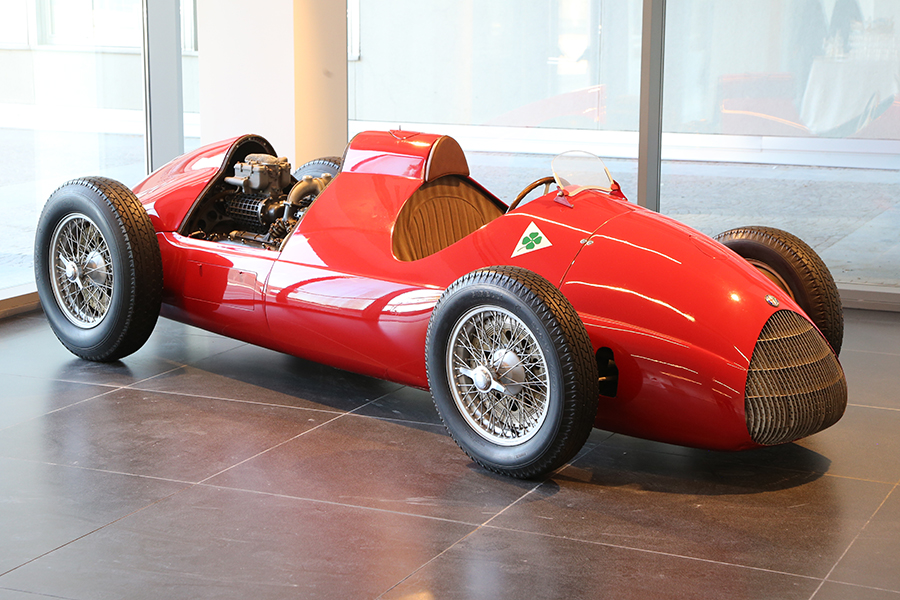


(First published on Autoshopper in Nov 2015)
Above:The Alfa Carabo concept of 1968
A stroke of luck allowed a recent visit to the recently re-opened Alfa-Romeo museum, located just on the outskirts of Milan, in Arese, near the site of the now-demolished old factory.
The environment is scrupulously clean both inside and out, with a smooth driveway leading to a clean, metallic-looking modern building which can be seen from the freeway, and displays the famous script along the top of the facade.
It was only as I spoke to friends after my visit that I realized how the museum had faded into the background, it was an un-museum, merely a display cabinet for remarkable artifacts: Alfa Romeos.
Perhaps this was something to do with my approach to museum. I went to the coffee shop on the top floor first, and had a fortifying panini and espresso. It is all very clean and modern, not antiseptic or cold, functional yet well designed doors, chairs, tables. Nearby, there was one of the two Tipo 512s built, looking like a rear-engined 158. It was sitting on its own, the only object in sight. I was enchanted. In hindsight, I realized that the red over the silver of the museum, the vintage car amidst the modern architecture, was compelling, because here it was obvious that a rare, technically cutting edge tour-de-force racing car, a piece of engineering, was also a piece of art.

Thus invigorated, I went downstairs and started at the beginning. Before any cars, a wall display tells the story of Alfa Romeo’s ridiculous, amazing, yes-that-is-a-snake-eating-a-man badge. The history includes ALFA’s emergence from the shadows of Darracq, their involvement with Nicola Romeo, the post-WW2 modernization of both company and emblem, and comes right up to date with the cleaned-up badge of 2015.

Across from the badges are perhaps a dozen aero engines, on stands. Did you know Alfa did aero engines? The one we have pictured is an 18-cylinder 48-liter radial, producing 2000hp. There are two banks of nine cylinders, overlaid, like beef patties in a gargantuan steel BigMac. Each bank has two stage supercharging—that is to say four superchargers in total, two on each bank.
Experience suggests that most people, myself included, can look at about one hundred cars before fatigue sets in. Many hotrod shows have thousands of cars far too many for anyone to absorb in a single day. The Alfa museum understands this challenge, making sure the high point cars, and the story of the marque did not get lost in a didactic model history. Themed halls were on split levels, such that they blended into each other, allowing different people in the group to move at different speeds through the exhibit, but the group to remain cohesive. Exhibits clearly resonated with Italians of different ages responding to the Guilias and ‘Suds the way American baby boomers do to muscle cars. The creative, stylish world of haute couture is centered on Milan, and is infused into Alfa-Romeo. This was very much on show, standouts being the teardrop-shaped Aerodinamica model of 1913 and the Carabo concept of 1968; did ever a car look lower?

However, it was the Motor Sport hall which truly enraptured me; the heroes of yore came alive with words and pictures on the columns supporting the roof over the cars; the photographs were rare, some of the anecdotes fresh (Farina is described as “a playboy”. In thirty years of reading about Farina, I had never read that before) Critically, the seminal car, the Tipo 158/9 was properly displayed. There were various examples on raised plinths; and you could walk around each.The different examples show a surprisingly transformative evolution—in plain terms, although the silhouette of the 158 was carried through the 159 evolution, comparing cars in the museum it was clear almost every element of the car was rethought. In this part of the museum, Italian Racing Red contrasted with a black backdrop. The over the top ice cream sundae was the next hall, of other racing cars—ground effects era V12 Formula 1 cars, T33s, GTAs. In two manageable hours, I was left in no doubt what is special about Alfa Romeo. This was not brand values, this was soul.


Years ago when visiting the Daimler-Benz museum, the teutonic efficiency was most striking, and in this the museum was as I have found Mercedes cars to be. And so it is with the Alfa museum; initially I didn’t see much to make a fuss about, but following my experience I was in love because sometime less is more, and the minimalist excellence of the design of the museum had allowed the exhibits to sing. This new museum captures the specialness of Alfa Romeo, it captures the way if Alfa were a woman, you’d want to marry it.
The company know this; they have a quote on the museum wall from the great Alfa designer, Orazio Satta Puliga:
“Alfa Romeo is more than a mere car factory: its products are something more than conventionally built automobiles. It’s a kind of fever, this enthusiasm for a means of transport. It’s a way of life, a very particular conception of the motor vehicle. Something that resists definition. Its component parts are like those irrational traits of the human spirit that cannot be explained with logical terminology.”







